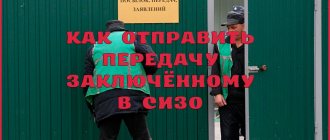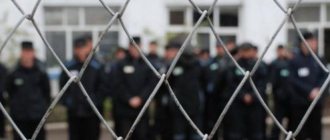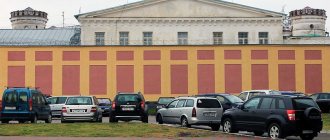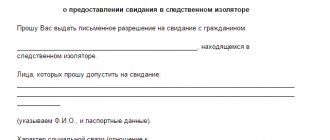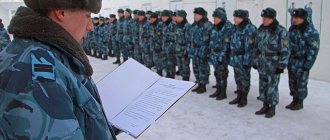Schedule
The daily routine of the inmates in Matrosskaya Tishina does not differ from the generally established rules.
Rise is at 6:00, lights out at 22:00. During the day, sleeping or lying on the beds is prohibited. Inmates are notified about the time of awakening and the need to prepare for bed by a special sound signal.
For a long time, Matrosskaya Tishina was overcrowded, so the convicts had to sleep in several shifts (due to a lack of sleeping places).
Residents' daily routine:
- Breakfast is served at 6:30 (the menu is no different from lunch and dinner, the diet consists of the first, second course and tea).
- Residents are given the opportunity to spend fifteen minutes a week in the bathhouse or take water treatments in the shower.
- Walks are held daily in a specially equipped and protected area (on average, one walk lasts an hour).
- The lighting devices in the cells operate around the clock (after 22:00 they are switched to night mode).
- Cell inspections are carried out daily from 8:00 to 9:00 (during the shift change of the convoy, complaints and wishes of the inmates are collected).
Who is sitting in the "Black Dolphin"? The list of prisoners is on our website.
What it is
The Matrosskaya Tishina prison is located in Moscow on the street of the same name.
Throughout its existence, the isolation ward has repeatedly changed its status and undergone reconstruction.
At the moment, on the territory of the prison there are several buildings, a hospital for prisoners and numerous outbuildings.
According to official information, the area of the cells reaches 12 square meters. meters, each of which houses 3-4 prisoners (in practice, the prison is constantly overcrowded). Particularly dangerous criminals are kept in solitary confinement.
- Prison address: Moscow, Matrosskaya Tishina Street, building 18.
- Telephone number of the duty department.
- E-mail address
- Infrastructure: three secure buildings (capacity up to 2000 prisoners).
- The official name of the prison: Pre-trial detention center No. 1 (Federal budgetary institution IZ-77/1 Federal Penitentiary Service of Russia for Moscow).
FKU Detention Center No. 2 of the Federal Penitentiary Service of Russia in Moscow
Address: 127055, Moscow, st. Novoslobodskaya, 45
Phone(s): 8-499-978-75-12
Head: Telyatnikov Sergey Veniaminovich
Attention! This map is for illustrative purposes only. The Yandex service is not yet able to accurately determine the position on the map in all cases. In more or less large populated areas, as a rule, the location is determined correctly, but in rural areas and remote areas errors are possible.
Extended information
FKU SIZO-2 Federal Penitentiary Service of Russia in Moscow
Federal State Institution "Pretrial Detention Facility No. 2 of the Office of the Federal Penitentiary Service for the City of Moscow"
Postal address: 127055, Moscow, st. Novoslobodskaya, 45
Contact phone numbers:
Duty department: 8-499-978-75-12
Fax: 8-499-978-75-12
Head of the institution: Telyatnikov Sergey Veniaminovich
Website: https://www.butyrka-sizo.ru/
Pre-trial detention center No. 2 occupies the territory and buildings of the Butyrsky prison castle. Built by M.F. Kazakov by decree of 1784 on the outskirts of the Miussky field near the Butyrskaya outpost, which determined its name; completed before 1792. Initially it was a cruciform building with a round church in the center, surrounded by a fortress wall with towers. A hundred years later, the sleeves of the cross were replaced by a solid square of five-story buildings, retaining only the round volume of the Church of the Intercession in the center of the courtyard with extensions around the first tier. Currently, the volume of the church is closed on all sides by three-story extensions; From the Kazakovsky building, only the rotunda has been preserved, divided into three tiers by ceilings. In the 1890s, buildings from the turn of the 18th-19th centuries adjacent to the fence. were rebuilt: the wall, with the exception of the towers, was dismantled, and four-story buildings with wide paired windows on the main facade rose along its entire length. At the end of the 19th century. The prison territory, which extended beyond the Cossack walls, was surrounded by an additional stone fence (dismantled in 1955). In 1912, part of it was replaced by a five-story stone building of a prison furniture factory, facing Novoslobodskaya (then Dolgorukovskaya) Street. Today, part of the fortress walls with towers, a church and later buildings have been preserved inside the quarter. Massive cylindrical towers, strongly protruding beyond the planes of the walls, secure the corners of the fence; their fortress character is emphasized by narrow loophole windows and a battlement-shaped finish. The names of the towers have been preserved: “Pugachevskaya” (until 1775 – South), “Police”, “Northern”, “Chasovaya”. On the southern façade of the castle, one of the original entrances with large arched openings and slender towers on either side has been preserved.
A distinctive feature of the prison church, dedicated to the Feast of the Intercession of the Blessed Virgin Mary, was the spacious balconies specially built on the 2nd floor, connected to the corridors of the prison buildings. Prisoners were taken from their cells to these balconies so that they could attend the divine service.
At the end of 1774, the tsarist troops suppressed the peasant war led by E.I. Pugacheva. The rebellious fugitive peasants and rebels were taken to the Butyrka prison castle under heavy guard, shackled and chained. The regime of detention was extremely harsh.
The history of the royal prison is closely connected with the history of the instruments of aggravating imprisonment: slingshots, stocks, shackles, handcuffs, chairs, chains, shackles and clamps. Prisoners were chained for the slightest offense. The slingshots were a special metal collar, on the outer surface of which there were from three to six sharp metal pins that did not allow the prisoner to lie down. There were three types of chains: worn on the arms and legs separately; on your arms, on your legs, on your neck together; on the legs and neck with attachment to the wall. The “chairs” were made from an oak block weighing 20–25 kg and bound with steel hoops, attached to the neck with collars and supported by hands. The prisoner was forced to carry it with him even to the toilet or bathhouse. “Chairs” were used to prevent escapes and burden the prisoners.
In 1889, the “New Normal Prisoners' Food Table”, published, streamlined the nutrition of prisoners by introducing standards for weekends and weekdays.
L.N. Tolstoy, while working on the novel “Sunday,” in January 1899 visited the warden of Butyrka prison I.M. Vinogradov and asked about the details of prison life. In April 1899, he came to the transit prison to walk with the prisoners to the Nikolaevsky railway station, and then described this path in the novel.
After the defeat of the revolution of 1905-1907, a convict department with a particularly cruel regime was created in Butyrka prison, and the death penalty was applied.
The Moscow Central Political Prison, which received its name at the end of the 19th century, saw famous people within its walls. They were kept here in 1904 - 1905 AD. Bauman, in 1905 N.P. Schmidt, in 1910 K.E. Voroshilov, in 1910 - 1917 F.E. Dzerzhinsky, as well as many participants in the December uprising of 1905.
In 1906, the Butyrka prison began to be called “Temporary convict, along with secret circulars, a completely new, extremely harsh regime was introduced, even “flogging” was introduced.
On October 1, 1911, the foundation stone for the women's department of the Moscow Prison Hospital was laid. On the same day, the building of the office, visiting room and service area was laid. In 1913, the construction of a military uniform workshop was started, in which from 700 to 800 prisoners worked.
After the October Revolution of 1917, chains and shackles were abolished, it was allowed to approach windows, transfers and visits were allowed. The Butyrka Church was liquidated, church literature and prayer books were confiscated. In the building of the former church, a hardware workshop and a forge for repairing carts and household equipment were organized. A large library was organized, and it was allowed to organize concerts of amateur and professional artists. So, in 1920, F.I. gave a concert in prison. Chaliapin.
From 1918 to 1956, the Butyrka prison was successively subordinate to various departments: from 1918 - the Cheka, from 1934 - the OGPU, from 1943 - the GUGB NKVD, from 1946 - the NKGB, from 1949 - the Ministry of Internal Affairs, from 1953 - the MGB , since 1954 - the Ministry of Internal Affairs, since 1956 - the Department of the Ministry of Internal Affairs of the Moscow Region, since 1956 - the Department of Internal Affairs (GUVD) of the Executive Committee of the Moscow City Council, since September 1998 - the Ministry of Justice of Russia. Currently, it is under the direct jurisdiction of the Federal Penitentiary Service of Russia in Moscow. During the last, third reconstruction (1956 - 1974), many structures were built, mainly for economic purposes: a gas distribution point, a boiler room, a club, warehouses, etc. In addition, exercise yards were built from brick masonry above the upper floors of three sides of the main building . In the main building on the ground floor there was a catering unit with a brewing shop and steam boilers, a bath and laundry complex for washing prisoners, washing clothes and treating clothes and bedding in steam disinfection chambers; Due to lack of space, the carpentry workshop's machines are located on the second floor.
In 1983, female prisoners were transferred to a separate five-story building, and in June 1996 they were all transferred to pre-trial detention center-6.
Currently, the prison Church of the Intercession of the Blessed Virgin Mary has been restored, and services are held there.
Since 2001, repair work has been carried out throughout the entire territory of pre-trial detention center-2. The security buildings have been completely renovated, and a major overhaul of the psychiatric hospital building is being completed.
Since July 2003, the department of psychiatry, narcology and psychotherapy for retraining and advanced training of medical staff has been functioning in the pre-trial detention center.
Currently, Butyrskaya Prison is under state protection as an architectural monument
Reception room opening hours
| Day of the week | Accepting applications | Working hours |
| Monday | 09:00 – 16:00 | 09:00 – 17:00 |
| Tuesday | 09:00 – 16:00 | 09:00 – 17:00 |
| Wednesday | 09:00 – 16:00 | 09:00 – 17:00 |
| Thursday | 09:00 – 16:00 | 09:00 – 17:00 |
| Friday | 09:00 – 15:00 | 09:00 – 16:00 |
| Saturday | 09:00 – 16:00 | 09:00 – 17:00 |
| Sunday | 09:00 – 16:00 | 09:00 – 17:00 |
4th Friday of the month – sanitary day
Information
Hope for the future
“Matrosskaya Tishina” (pre-trial detention center) has varied reviews. Most often, the quality of medical care provided here is not very flattering. According to many people whose relatives are in isolation, medical care is either not provided in a timely manner or is not provided at all. There is often talk about overcrowding in cells, that is, they contain more prisoners than they should be. This also affects personnel who guard those serving sentences or awaiting their sentence. According to the rules, one guard should accompany no more than four prisoners, but in reality there are between seven and nine of them. The head of the pre-trial detention center is trying his best to change the situation for the better.
How and what to get there
The pre-trial detention center is located near the Sokolniki metro station.
You can get from the metro to the detention center by ground public transport.
Tram 4L stops 120 meters from the metro. You can travel one stop on it. You need to get off at the stop “Malaya Ostroumovskaya Street”, then walk 650 meters.
In addition, from the Sokolniki metro station you can take buses 14 and 41, from which you need to get off at the “Korolenko Street” stop and walk 550 meters. Travel time from the metro by transport will be 10-15 minutes.
At the same time, you can also get to the pre-trial detention center on foot; to do this, from the metro you need to turn right onto Barbolina Street, at the first intersection turn left onto 2 Boevskaya Street, then cross 1 Boevskaya Street and turn right onto Stromykinsky Lane, after which you need to go left along Matrosskaya Tishina Street.
It is there that you can find the Matrosskaya Tishina pre-trial detention center. If you are going to get there on foot, the travel time along the indicated route will be 17-20 minutes.
In addition, the Elektrozavodskaya railway platform and the M-Tov-Ryazanskaya platform are located nearby. You can also get there from the Elektrozavodskaya, Krasnoselskaya, Baumanskaya, Semenovskaya and Komsomolskaya metro stations.
The “Matrosskaya Tishina” pre-trial detention center is located in the center of Moscow. Here, as in any institution that houses prisoners, there are strict rules of conduct for both prisoners and those who visit them.
History of the Strait House from 1775 to the present day:
https://youtube.com/watch?v=5dzgG_PfHtU%3Fecver%3D1
Didn't find the answer to your question? Find out how to solve exactly your problem - call right now:
| Share with friends: |
Did you like the article? Follow site updates or.
Comments:
Pros and cons of sending a parcel through the Ozon online service
Before moving on to a comprehensive assessment of the service, it is necessary to understand how the sending process works.
- Registration on a suitable service;
- In a special form we indicate the details of the recipient and sender;
- The service will offer an assortment available for shipment, select what you need;
- At the final stage, you need to check all the data again and pay for the parcel.
Let's start with the undeniable advantages of this type of service.
- A modern method of delivery that does not take much time;
- Convenience - you can collect the shipment and send it at any convenient time and anywhere. The main condition is a stable Internet connection;
- Safety. Transfers are subject to strict rules regarding the contents of the package. It is simply impossible to remember all the restrictions and nuances and there is a risk of sending something prohibited. If during inspection any unsuitable items are found, then, at best, the shipment will be sent back. But most often it is sent for disposal. This cannot happen when using the Ozone online service. The service offers only permitted items for shipment. The buyer does not have to worry that the parcel will contain any inconsistencies with the law;
- Complete anonymity of the sending process. Many relatives feel awkward sending a parcel to a pre-trial detention center. When using the Internet service, no one will know where the package was sent;
- Several types of payment are available. A bank card is not required to send. It is possible to pay via bank transfer.
If we talk about the disadvantages of online sending, we can highlight the following points:
- The service is not yet available in all pre-trial detention centers;
- Higher prices. Sending using the service costs more than a similar service by mail;
- Limited range of brands and products;
- It is impossible to check the quality of ordered goods.
Important. Sending a parcel to a pre-trial detention center using the online service is only possible by postal delivery.
About the scandal with VIP cameras
In December 2022, Matrosskaya Tishina became the subject of a serious scandal, as a result of which several people were removed from leadership positions, some of whom came under investigation.
During the inspection, the POC commission discovered VIP cells in the prison, the arrangement of which was radically different from the standard places of detention for inmates.
It turned out that some of the most dangerous swindlers were serving their sentences or awaiting a court decision in such premises. At the same time, in the main building there is a global overcrowding of the cells (facts of 12-15 people being placed in one cell have been revealed).
Details of the scandal:
- The VIP cells have undergone a major overhaul; each of them has a plasma TV, a refrigerator (products do not pass inspection), good quality furniture, personal baths and toilets, including showers, as well as other household items not typical for detention center or prison.
- Prisoners in VIP cells can use communication equipment uncontrollably (in addition, they are not subject to searches to identify prohibited items).
- Each cell with VIP status contains one inmate (or several, but with their consent).
- When asked by human rights activists about the history of the creation of VIP cells, the detention center referred to donations, most of which were aimed at improving conditions for prisoners.
- It was also explained to human rights activists that all convicted, under investigation or suspects can be held in VIP cells (but in practice this rule was grossly violated).
- After the announcement of information about VIP cells in Matrosskaya Tishina, members of the POC commission were prohibited from inspecting the prison (the event also caused a scandal).
Sailor's silence has repeatedly become the object of scandals and investigations.
Reports regularly appear in the media about fatal torture of convicts, high levels of corruption and other events that negatively affect the reputation of the prison.
About VIP cells for special prisoners in “Matrosskaya Tishina” in this video:
https://youtube.com/watch?v=ReJr_eeb_2U%3Fecver%3D1
Didn't find the answer to your question? Find out how to solve exactly your problem - call right now:
| Share with friends: |
Did you like the article? Follow site updates or.
Comments:
Features of transmissions depending on the time of year
It should be noted right away that the list of necessities differs depending on the time of year.
For winter, naturally, the list will be larger. And these are not only warm clothes, but also food, since in the summer, usually from April to November, there are strict restrictions on perishable foods.
This is due, trivially, to the lack of refrigerators. But some cells have them, as do kettles with TVs. The presence or absence of a refrigerator in the cell will become known only after the prisoner is transferred from the quarantine cell to the general one.
But I’ll make a reservation right away: FSIN employees practice relocating prisoners from one cell to another. This does not happen every day, as a rule, but, depending on the decision of the special department, it can happen to an individual prisoner or group several times every few weeks.
List of basic things and hygiene products, features of summer programs
So, first, let's look at the summer version of what we need in everyday life. The main thing is to remember that the total weight, and this is VERY IMPORTANT, should not exceed 30 kilograms.
This is exactly the weight that is provided by law to be transferred to a prisoner once a month. And if you decide that a couple kilos of tomatoes is good, then, alas, as a rule, this is not the case.
Let's start, as they call it, with soap and snout accessories:
- Toilet soap - 2 pcs.
- Soap dish - 1 pc.
- Toothpaste - 1 pc.
- Toothbrush - 1 pc.
- Brush case - 1 pc.
- Shampoo - 1 transparent bottle in a plastic package.
- Shower gel - 1 transparent bottle in a plastic package.
- Washcloth - 1 pc.
- Set of disposable razors such as Big or Gillette.
- Shaving foam or gel. If gel, then also transparent and 1 pc.
- Alcohol-free aftershave lotion - 1 pc.
- Packing of ear sticks - 100 pcs.
- Comb type comb.
- Alcohol-free deodorant stick type.
- Washing powder for hand washing - 1 pack.
- Hand towel – 1 pc.
- Bath towel – 1 pc.
- Toilet paper 4–6 rolls, no less.
- Nail clippers are required for cutting nails as scissors are prohibited.
- Bath slippers, usually ordinary rubber slippers, preferably black or at least dark in color - 1 pair.
- Dishwashing liquid - 1 pc.
- Sponges for washing dishes 3–5 pcs.
This part alone takes up at least 3 kilograms, which is quite noticeable. The advantage is that there are several items for several months at once, which in the future will help save space for other necessary things. It should also be added that women need personal hygiene products.
Next, let's look at personal items.
It is necessary to understand that a large number of things only harms. Firstly, there are no places for storage, and secondly, when transporting, it is difficult to carry two trunks, and if there are more, then it is almost guaranteed that they will simply be thrown away.
Thirdly, after being transferred to the zone, almost all things are selected and they are given a uniform; their things are transferred to the storage warehouse. If you don’t pick them up from there in the next month, they will turn into dust, since the storage conditions are terrible: there is dampness, mold, and other joys, and the possibility of theft cannot be ruled out if the item is good. It doesn’t matter if it’s a jacket, boots or a T-shirt - anything can grow “legs”.
So here is the list of things to do in the summer season:
- Sports bag or trunk - 1 pc. The bigger, the better. If a person needs a second one, then clarify this on the date and prepare for the next month.
- Laceless shoes (shoes/sneakers) that the prisoner will wear to meetings - 1 pair of strictly black color. The color is necessary so that upon arrival at the colony they are not taken away, but left for sports. Without any frills, colored inserts, or protruding logos. It’s better to color everything in advance with a black waterproof marker.
- Slippers such as slates for being in the cell and going for a walk - 1 pair.
- Black cotton socks - 5 pairs.
- Briefs 3–5 pcs.
- Alcoholic T-shirt, black, without inscriptions, 2–4 pcs.
- T-shirt black, without inscriptions 3–5 pcs.
- Black long johns, “sweatpants” type, cotton — 2 pcs.
All of the items listed above can be kept at camp. You will also need specifically for the pre-trial detention center:
- Black tracksuit. Paint over all emblems and inscriptions. Perhaps it will also remain, but if it is expensive, like Bogner, then, most likely, the owner will only wear it in a pre-trial detention center.
- Things to wear when going to court: jeans, sweatshirt, shirt, windbreaker. There are no irons there, shirts and T-shirts cannot be ironed, things should not be expensive so as not to regret their further loss.
- Turtleneck: It can be cold in May and August, so this is a great help.
Here's a couple more kilograms added, the weight of the trunk itself will also be taken into account. And these are just summer things.
What should be added to winter programs
If the period fell from August to April, then the following must be added:
- Thermal underwear - 2 pcs. Or warm long johns with fleece and turtlenecks, all black, 2 pieces each.
- Warm knitted sweater with a neck, 1 piece, inexpensive, most likely, it will not be useful except in a pre-trial detention center.
- Warm winter jacket with a hood.
- Warm winter boots, black, with a zipper, without laces.
- Knitted or fleece hat and gloves.
It is unlikely that anything will be left at the camp except boots. And only if the latter are not available, and yours are similar to the established model, such as “farewell to youth” or ankle boots. Warm clothes are extremely necessary, since the temperature in the cell may not differ much from the temperature outside.
The winter version adds at least 1.5 kilograms of weight. Thus, 6–8 kilograms are used.
Out-of-season small items that need to be transferred to the pre-trial detention center
There are still necessary things:
- Boilers 0.5 kW - 2 pcs. They burn quickly for various reasons, but are almost always necessary. One for tea, the second for technical needs such as washing. There may not be any teapots. Only 0.5 kW, since more powerful ones are prohibited.
- Checkered notebook 96 sheets - 2 pcs.
- Ballpoint pens, not gel (this is important!), blue, black 4–5 pcs.
- Regular size postal envelopes - 5 pcs. and A4 format - 5 pcs.
- Postage stamps of various denominations for a total amount of 500 rubles.
- Files for documents 10 pcs.
- Plastic containers for food 250 g, 500 g, 1 l, one piece each.
- Preferably the Criminal Code of the Russian Federation, the Code of Criminal Procedure of the Russian Federation, the Criminal Code of the Russian Federation.
All together this is another 300–500 grams.
Reception schedule for citizens
Citizens can get an appointment from 14:00 to 16:00 daily.
Statements from relatives
Relatives can apply for a visit. A sample application can be found on the official website.
Transfers
The parcel can be given to the convicted person on Sunday from 9:30 to 14:00.
Each convicted person in prison has the right to receive no more than 6 parcels per year, that is, a parcel can be delivered once every 2 months.
You can transfer no more than 20 kg of items. Convicts who are in lighter conditions have the right to count on monthly transfers.
You should not transfer items that are prohibited for use in the pre-trial detention center. By handing over such items, you provoke the prisoner to commit violations, which, in turn, will result in disciplinary action.
In addition, you can support the prisoner by sending a parcel. Each prisoner has the right to receive parcels whose weight does not exceed 30 kg per month, the weight of all parcels is summed up.
Dating
According to the law, persons held in pre-trial detention centers are entitled to no more than two visits per calendar month. Visits may include both relatives and other persons. No more than 2 people are allowed on dates.
For each such meeting, it is necessary to draw up documents indicating who can meet with whom. Documents can be processed from Monday to Thursday from 9630 to 16:00, on Friday from 9:30 to 15:00, on Saturday and Sunday from 9:30 to 14:00.
The last Monday of every month is a sanitary day.
Persons who have not provided identification documents, as well as those who arrive under the influence of alcohol or drugs, are not allowed to visit.
Employees have the right to terminate a visit in case of violation of the rules in force on the territory of the pre-trial detention center. Dating takes place on a first-come, first-served basis.
A long date is allowed once every 3 months. If the prisoner is kept in light conditions, a long visit can take place once every 2 months. There is a fee for using the room for long meetings.
It starts at 9 am. The police will allow no more than 2 people, which includes minor children. If a person who has arrived for a long date leaves the room intended for him, then the date is considered to be over. You won't be able to get there a second time.
A convicted person has the right to receive meetings with a lawyer for a duration of 4 hours without restrictions.
Individual appointment
Citizens can get an appointment individually on Tuesday, Wednesday and Thursday from 9:30 to 16:30.
On Tuesday the reception is conducted by the Deputy Chief for General Affairs Oleg Midekhatovich Gafarov, on Wednesday you can get an appointment with the Deputy Chief for Security and Regime Sergei Pavlovich Kozlov, on Wednesday the reception is hosted by the Acting Chief Anton Stanislavovich Podrez.
Basic rules for packing items
The number of parcels that a colony prisoner can receive during the year depends on the regime, as well as conditions, and is determined by Articles 121, 123, 125 and 131 of the Penal Code of the Russian Federation. Along with this, there is a limit on the weight of food, clothing and items that a prisoner can have with him - no more than 36 kg (Order of the Ministry of Justice of the Russian Federation dated December 16, 2016 No. 295).
Russian Post does not accept items heavier than 20 kg.
The permitted dimensions of the boxes are 190*130*350 mm.
To avoid misunderstandings, before sending a parcel to a prisoner via the Internet or mail, check the relevant points with the administration of the correctional institution.
How to send a parcel to a prisoner in a pre-trial detention center or colony:
- Familiarize yourself with the rules for packaging, transfer, and such shipments.
- Pack everything carefully and deliver it to the collection point.
- Pay for shipping, fill out a declaration.
- Receive a receipt with a tracking number.
In the case of online stores, everything is simpler - just select the goods, put them in the cart, and indicate the coordinates of the colony as the delivery address. Before sending a package to a prisoner, read the list of permitted and prohibited products and items.

